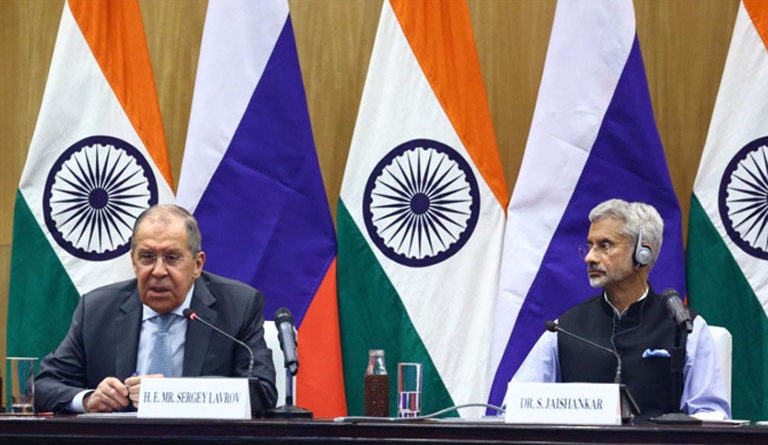Russia Nudges India To Not To Turn QUAD Into A NATO-Like Military Alliance For Asia
April 06 2021
Russia indicated that it was aware of speculation about India, Japan, Australia and the United States turning the Quad into a NATO-like entity for Asia Russia’s Foreign Minister Lavrov and his Indian counterpart Jaishankar attend a news conference in New Delhi. Credit: Reuters Photo
Russia on Tuesday tacitly nudged India to stay away from any move by the United States to turn the Quad into a NATO-like military alliance in order to contain China in the Indo-Pacific region.
Moscow dismissed speculation about a Russia-China military alliance. It, however, also indicated that it was aware of similar speculation about India, Japan, Australia and the United States turning the Quad into a NATO-like entity for Asia. After a meeting with External Affairs Minister S Jaishankar, Russian Foreign Minister Sergey Lavrov said that Moscow and New Delhi shared “a common stance” that such military alliances would be “counterproductive”.
Jaishankar, however, apparently justified India’s engagement with Japan, Australia and the United States on Indo-Pacific within the framework of the Quad. “I shared (with Russian Foreign Minister) our view-point on the Indo-Pacific. As our Prime Minister pointed out at the Shangri-La Dialogue some years ago, contemporary challenges require countries to work together in new and different ways,” he told journalists after his meeting with the Russian Foreign Minister.
Lavrov reached New Delhi late at night on Monday – less than a month after India joined Japan, Australia and the United States to elevate the Quad to the level of the Heads of Government. Prime Minister Narendra Modi on March 12 virtually joined his counterparts in Japan and Australia – Yoshihide Suga and Scott Morrison – and the US President Joe Biden in the historic first summit of the coalition, which the four nations had originally forged in 2007, but revived in 2011, ostensibly to build a bulwark of democratic nations to counter hegemonic aspirations of communist China.
“Russian-Chinese relations have achieved the best level in history, but these relations do not pursue the aim of creating a military alliance,” the Russian Foreign Minister said during a joint news conference with his counterpart in New Delhi. He noted that similar speculation was doing the rounds about the possibility of some other military alliances being forged. “There have been speculations about pushing ahead with projects for creating a Middle Eastern equivalent of (the) NATO. Lately, some have begun to discuss an ‘Asian NATO’,” Lavrov said, adding that he and Jaishankar had exchanged opinions on the issue.
He had in December 2020 called the Quad a ‘divisive’ and ‘exclusivist’ tool, which was being used by the US to implement its “devious policy” of engaging New Delhi in games against China as well as to undermine Russia’s close partnership with India. Jaishankar told Lavrov on Tuesday that India’s engagement with Japan, Australia and the US had also reflected the multi-polar and rebalanced character of global politics.
“India is strongly committed to ASEAN (Association of South East Asian Nations) centrality and this is underlined by the Indo-Pacific Oceans Initiative that it has been advocating at the East-Asia summit,” Jaishankar said, adding: “As we implement our Act East and beyond policy, Russia is a very important partner. Whether it is their Far East or whether it is the Chennai- Vladivostok Corridor.”
The Quad got a military heft last year amid China’s growing belligerence, not only along its disputed boundary with India, but also in the disputed waters of the South China Sea, East China Sea and the Taiwan Strait. India clinched defence logistics sharing agreements with Japan and Australia on the lines of the similar pact it inked with the US in 2016. The Quad also held the Malabar 2020 naval drill in the Indian Ocean, sending out a strong message to China.
The stand-off between the Indian Army and the Chinese People’s Liberation Army (PLA) started in April 2020 and it is yet to be completely resolved. Russia played a behind-the-scenes role of a mediator between India and China. A meeting between Jaishankar and the Chinese Foreign Minister Wang Yi on the sideli e of a meeting of the Shanghai Cooperation Organization (SCO) in Moscow on September 10 last year resulted in a breakthrough.
The two sides a few weeks back withdrew front-line troops from the northern and the southern banks of the Pangong Tso lake, but could not yet agree on similar disengagement on other face-off points along the Line of Actual Control (LAC) – the de facto boundary between the two neighbouring nations in the western sector.
Also read: Sergei Lavrov, Jaishankar discuss Russian military manufacturing in India India’s growing strategic convergence with the United States in the Indo-Pacific region in the aftermath of the military stand-off between the Indian Army and the Chinese PLA, however, caused unease in Russia. India sought to strike a balance and had a separate naval drill with Russia in the Indian Ocean region in December 2020.
Lavrov and Jaishankar on Tuesday discussed a common understanding of the principles of shaping a reliable security architecture in the Pacific and Indian Ocean, the Ministry of ForeignAffairs of the Russian Government stated.
Lavrov left New Delhi for Islamabad after meeting Jaishankar in New Delhi on Tuesday. Moscow apparently sought to send out a message to New Delhi by clubbing his visits to India and Pakistan. New Delhi has been conveying its concerns to Moscow over increasing Russia- Pakistan cooperation, particularly in the defence sector.
Courtesy: Deccan Herald

